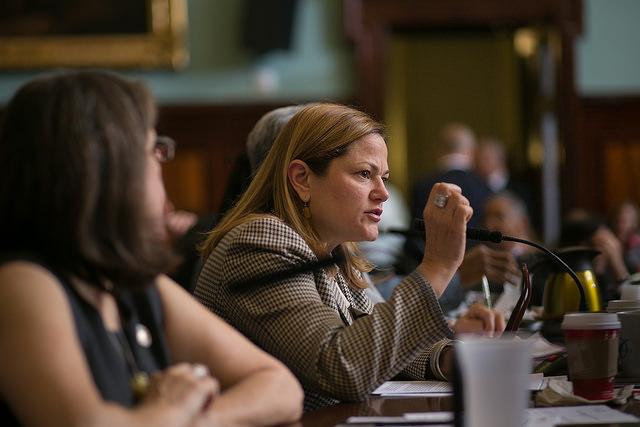NEW YORK—Affordable housing has been a focus of new mayor Bill de Blasio’s campaign, and rent-regulated apartments make up the bulk of affordable housing units in the city.
The city has about 1.1 million rent-regulated units that house over 2.5 million New Yorkers, but thousands of units exit rent-regulation every year for a variety of reasons.
Housing advocates say this problem has only worsened as the real estate market heated up. Landlords in once-undesirable neighborhoods now have the option of renting units to those who can afford to pay much more.
The result is that longtime New Yorkers are leaving the city for places like Phoenix, Ariz., Georgia, North Carolina, said Assembly member Karim Camara.
“They’re devastated,” Camara said. “They’re moving not because they want to be in a city with a sunnier climate, not because they’re retiring, but because they’re priced out. They don’t want to leave.”
These are mothers and grandparents looking after children in high school or college, he said, and they call his office looking for a way to stay. But if it is a matter of money, there is not much a legislator or legal office can do to help. So the families leave.
Tuesday morning, a coalition of tenants, city council members, and state elected officials rallied in front of City Hall to call for stronger rent laws that would preserve affordable housing.
City Council Speaker Melissa Mark-Viverito said tenants would organize and rally in Albany with the City Council’s support.
State Rule
Next summer, the rent laws expire and will be up for renewal by the state legislature.
Ultimately, city officials and tenants want the city to have control over the rent laws—not the state. This would require repealing the Urstadt Law, which was passed in the 1970s to give the state control over tent laws as the city was near bankruptcy.
Democratic state senators and assembly members said repealing the Urstadt Law would be unlikely unless Governor Andrew Cuomo pushed for it.
“It would shift the policy to the people who actually live in the city of New York and have to be accountable to the people of the city of New York, so I think it is a win-win to do so,” said Senator Liz Kreuger, who had sponsored a bill to repeal the Urstadt Law. It went nowhere in the Senate, and she does not foresee a better result this year with the Republican majority, she said.
“But I think it is a very hard fight to win,” Krueger said. “Upstate legislators have no idea about the realities of rental housing.”
City council members want home rule on rent laws to avoid having to address issues that plague rent-regulated tenants one by one through different pieces of legislation at the state level. State legislators said it would be a more realistic goal, however.
Tenant Issues
Horror stories of rent-regulated tenants being harassed to leave are abundant. Tenants often deal with tactics designed to make them pay more, move out, or have their apartments removed from rent-regulation, advocates said.
There are currently several bills at the state level that address some of the recurring problems.
For instance, many regulated apartments exit regulation when a tenant moves out and improvements are made to the unit. Senator Andrea Stewart-Cousins and Assembly member Linda Rosenthal sponsored bills to prevent this by re-regulating most of such apartments that were de-regulated in the last 15 years.
Landlords are also allowed to raise rents on an apartment by 20 percent when a tenant vacates the regulated apartment, and another bill sponsored by Senator Jose Serrano and Assembly member Brian Kavanagh would get rid of that.
Senator Liz Krueger and Assembly member Daniel J. O'Donnell sponsored bills that would curb what many call a loophole to overcharge tenants outside of their regulated rents.
Tenants frequently have to pay for capital improvements made to their buildings on top of their rent, and there is currently little oversight over whether the improvements were made or the effects of those improvements on tenants. The bill would cap the extra charge and make the fees temporary.
Affordability
Officials and advocates say the city is in the midst of the worst housing crisis ever.
In the past two decades, about 100,000 affordable units have been lost. Average rents increased nearly 40 percent in the same time citywide.
In 2012, over half of the city’s rental households were rent burdened and paid at least 30 percent of their incomes toward rent. About a third of rental households were severely rent burdened, paying at least half their incomes toward rent.
In response, the de Blasio administration put forth a $41 billion plan (public and private) for the next decade to preserve 120,000 affordable units and build 80,000 more.
New York is actually not the most expensive city in the country, according to rental reports over the past year. A recent report by listing site Zumper reconfirms that the most expensive rental city is San Francisco. The median price for a one-bedroom apartment in San Francisco is $3,370/month. For New York, it’s about $3,000.
The Citizen’s Budget Commission put out a series of studies this fall, which looks at the affordability of the city. It ranked the city sixth in highest rent and ninth in worst affordability compared to other major cities in the country.
“New Yorkers tend to think of themselves and their city as unique. With respect to affordable housing, this view is only partly true,” according to the report.
While rents are high, cheap transit in many areas of the city offset housing costs, according to the reports.
What is most concerning, according to the reports, is the stark lack of supply for low-income and very low-income households. Their costs continue to outpace wages and they pay higher percentages on housing and location costs.
Nationwide, no major city is affordable to low-income households, according to the report.





